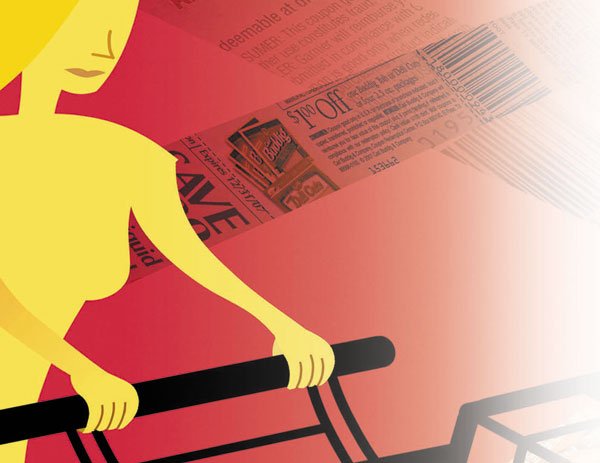Michelle Harrison recently paid 10 cents for $40 worth of
groceries.
”
And it would’ve been more, but the store had a 20-coupon per
transaction limit,
”
Harrison says, laughing.
Michelle Harrison recently paid 10 cents for $40 worth of groceries. “And it would’ve been more, but the store had a 20-coupon per transaction limit,” Harrison says, laughing.
She and fellow coupon diva Frances Bullock say it’s not hard to get there.
The frugal friends say in a typical week they save about 70 percent off their grocery bills after a couple of hours of clipping and sorting.
And during a store’s triple coupon promotion, they can get most of their groceries for free. So many items, in fact, they often have enough to donate to area food pantries.
As rising gas prices and the slowing economy create fresh anxiety about family budgets, coupons are an easy way to stretch a buck.
The Charlotte, N.C., moms approach coupon management like a part-time job. But they stress that even folks who work full-time can save at least 50 percent off their groceries with just two hours of clipping and planning, and a couple more to shop at multiple stores each week.
Bullock, 38, says her savings in the first six months of this year will pay for a Walt Disney World vacation for her family. She’s a stay-at-home mom to Ethan, 6, and Gavin, 3, and wife to David.
Harrison, 36, is a CPA, and says her savings have allowed her to maintain her family’s lifestyle after reducing her work schedule. She now works part-time so she can be with son Ryan, 2, and husband Dwayne more often.
“I had always clipped coupons on a casual level,” Harrison says. “A year ago, there was a triples event at Lowe’s Foods and I scored $125 worth for $25 and thought I’d done great. But then I talked to another couple who’d gotten $250 (worth) for $25 and I thought ‘Holy cow!'”
That’s when she started devoting more time to planning her coupon use.
Bullock says she’s always been frugal but got extra serious about coupons after her boys were born and she stopped working outside the home.
They both started reading Internet coupon forums for tips and to get links to printable manufacturer’s coupons. They also began paying more attention to store circulars and started tracking prices on items their families use most.
They estimate that extra time and mindfulness have doubled their savings.
“One great deal I got recently was at Lowe’s Foods when they had cereal buy-one-get-one-free,” Harrison says. “I had four coupons for 70 cents off, so for four boxes of Kellogg’s cereal, I paid a total of 95 cents. And the register spit out a coupon for $10 off my next shopping order, which I knew would happen because I read it on an online forum. So, in effect, they were paying me to shop there.”
INSERTS AND SWAPS
Both women buy multiple copies of the Sunday newspaper to get extra coupon inserts and participate in a free, local online coupon swap. They also organize their coupons in three-ring binders, tucking them into the pockets on clear plastic baseball card pages.
“I have them all sorted by categories and divided by different color tabs so I can flip to them easily” in the store, Bullock says.
Their actual grocery shopping takes the least amount of time, though both visit at least two stores every week. (They each bring a cooler to store perishable items in their cars.)
“I don’t spend much time in each store since I do most of my planning at home and my shopping list is made out before I leave the house,” Bullock says.
KNOW THE POLICIES
Along the way, they’ve learned the importance of knowing each store’s coupon policies.
Some have strict rules about Internet printable coupons, and others will double coupons worth up to 99 cents only. It also pays to know which stores allow “stacking,” coupon-speak for using a manufacturer’s coupon along with a store coupon on the same item. See store Web sites for policies.
Both women say shoppers should pay great attention to what the regular price for individual items is at different stores.
“Just because you have a coupon or it’s on sale doesn’t mean it’s a good deal,” Harrison says. “A sale can mean just 10 cents off, and it might be smarter to save your coupons. Items tend to hit their lowest price about every 12 weeks. You should always try to combine a sale with a coupon to get the biggest savings.”
Harrison says she’s learned to be creative about where she gets her coupons.
“Go through your cupboard and figure out what you buy and use on a weekly basis,” she says. “Contact those manufacturers, compliment their products and ask for coupons.”
And where beer and wine is sold at grocery stores, she suggests checking for tear-pad coupons near the beverages. She often finds savings on meat and seafood there.
Bullock and Harrison say they follow the rules – they don’t try to use expired coupons or ask stores to bend their policies.
“If it’s a really good sale, then I try to go just every few days so I don’t take all of the items from the regular customers,” Bullock says. “Never clear a shelf! That to me is bad coupon karma and greedy.”
MAXIMIZE YOUR SAVINGS
1. Organize coupons in a binder or accordion file. Separate into categories according to item type and arrange by expiration date.
2. Go online. Manufacturer Web sites offer deals for $1 or more off. Discussion boards at sites including HotCouponWorld.com and AFullCup.com have members sharing links to printable Internet coupons.
3. Buy multiple copies of the Sunday newspaper to get extra coupon inserts.
4. Consider using the $1 trial membership at TheGroceryGame.com to learn how to combine coupon use with store sales.
5. Take advantage of triple coupon promotions at grocery stores.
COUPON stats
– 86 percent of Americans use coupons.
– 80 percent of manufacturer’s coupons are distributed through Sunday newspapers.
– Shoppers saved about $2.6 billion in 2007 with manufacturer’s coupons.
– Coupon users report an average savings of 11.5 percent each trip.
– Manufacturers offered approximately $330 billion in coupon savings in 2006.
HISTORY OF COUPONS
1894: Coupons are born. Asa Candler, the druggist who bought the formula for Coca-Cola, gives out handwritten tickets for a free glass of his new fountain drink.
1895: C.W. Post distributes the first coupon worth 1 cent toward his new product: Grape Nuts.
1930s: Coupons become a staple in American households because of the Depression.
1940s: Supermarkets sprout across the country and continue the coupon tradition that began in neighborhood groceries.
1957: The Nielsen Coupon Clearing House becomes the first business devoted to coupon redemption. Coupons have created a new industry.
1965: One-half of Americans are coupon users.
1975: More than 65 percent of American households clip coupons.
Coupons do an evolutionary leap
Gone are the days of scissors and papercuts – new services, such as Mo-Quepons, offer great deals sent directly to your cell phone.
At Mo-Quepons, cell phone users sign up for free and choose which local stores they would like to receive offers from. Then, those stores periodically send out text messages with deals offering everything from substantial discounts on purchases to free bottles of wine or free car vacuum tickets. All the customer has to do is show up with his or her cell phone to redeem the offer.
For advertisers, Mo-Quepons offers all the usual perks of coupons – finding new customers and spurring business – while offering the advantages of timeliness and tighter focus. Because the text messages are instantaneous, advertisers can send out deals when they’re most relevant – say, offering a free croissant with a cup of coffee just as folks are starting their day. And because customers sign up for deals, advertisers know that they are only sending deals to their target audience.
Online coupon services like Mo-Quepons take advantage of the digital age, using technology to offer customers and advertisers an easier and more efficient way to connect.
To sign up for free local coupons, visit www.mo-quepons.com. Mo-Quepons is operated by South Valley Newspapers, which also runs the Gilroy Dispatch, Hollister Free Lance and Morgan Hill Times.














